Text
Elimination Mode
We all learn something new every day. In this case, I remembered something that I hadn't thought of since my childhood.
Recently, I have been replaying the original Legend of Zelda, only this time I have been fighting my way through the second quest, a much harder version compared to the first. Over the last week or so, I managed to collect a decent amount of heart containers, buy the blue ring, and fight my way through the first three dungeons while making decent progress on the fourth.
Today when I booted up the game on my Switch, my fiancée asked "What's elimination mode?" Without thinking, I clicked on it, thinking it would be similar to the Timer mode on the Legend of Zelda Game & Watch, a mode that allows you to fight hordes of enemies while a timer counts down. I selected my second quest save file and *poof* - no more save file.
That may have been one of the dumbest things I have done in awhile. Last week I beat Demise for the first time, and this week I couldn't remember that "Elimination mode" meant "delete file."
Don't worry, I typed this up after I restarted and beat dungeon 1 again, and I'm on my way to beat dungeon 2. Hopefully I can get through the game before Tears of the Kingdom takes up all of my free time in a few weeks.
#the legend of zelda#loz#nes#not my brightest moment#haven't had to delete a save file since I played on my NES at age 8#oh well
10 notes
·
View notes
Text
Let’s Talk the Twilight Princess Manga- Book #1
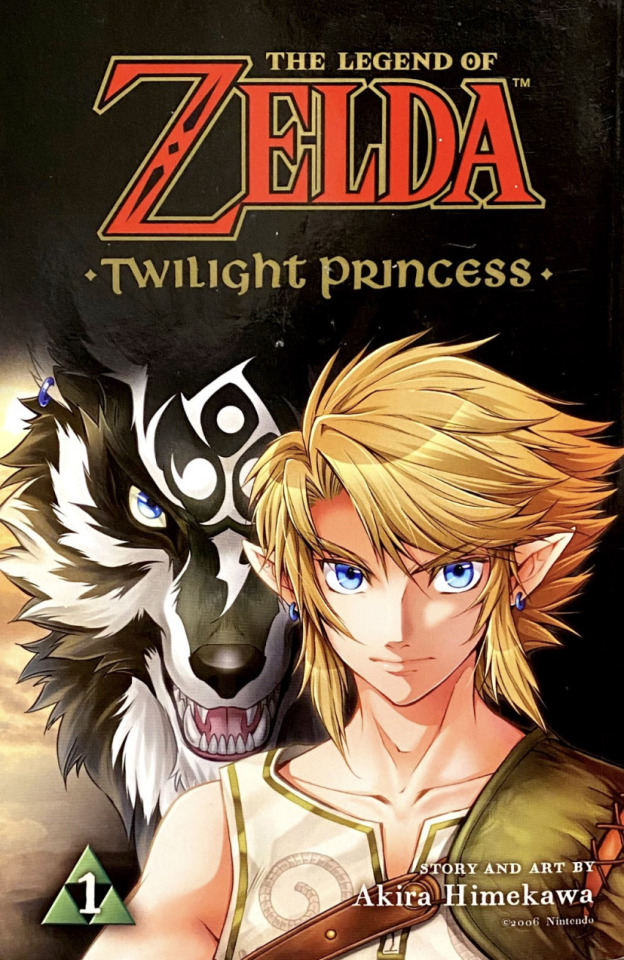
Released on March 14, 2017, volume 1 of Akira Himekawa's Twilight Princess manga adaptation kicks off an 11 part series retelling the story from the original game from 2006, Twilight Princess. The final volume of the series came out in English the other day on April 11th, 2023. With 11 volumes over 6 years, I figured now is a good time to go through the series and see how well it holds up. Since this is a longer series, each book will get its own post. I have a lot of opinions about this adaptation of Twilight Princess, so let’s talk about it.
The Good

First of all, the art style that Akira Himekawa uses for this series is easily the best we’ve seen out of The Legend of Zelda manga adaptations. The amount of detail put into every page perfectly captures the vibe of the scene and the emotions of the characters involved. As someone who has read the other 10 volumes, let me tell you that the art only improves from here, and it's already very solid. The art style is the number one thing I hype up about this series when I recommend it to other people. Even if some of the changes they make in this adaptation don’t work for you, I suggest picking it up anyway for the art alone.

Rusl is another highlight, especially in volume 1. Himekawa perfectly captures that stern but caring father figure vibe for Rusl, having him be the voice of reason while also being the one to comfort Link early on. He also takes his job as the protector of Ordon seriously. I like Rusl in the game, but I feel like we see more of his personality in the manga. Maybe I’m biased because I hate playing through the opening section of Twilight Princess and zone out until we hit the first temple, but even so Rusl is a much needed character in this first volume.


Something else I greatly appreciate is the T rating here feeling earned. The manga adaptation takes those scenes that likely gave the game a T rating in the first place and elevates them, raising the stakes a considerable amount. While I love the previous manga adaptations of Legend of Zelda games, they were all clearly made for children. I appreciate Himekawa giving us a series that doesn’t shy away from its rating.
The Bad

In the first couple of pages, we're shown scenes of Midna fighting alongside a wolf. It's difficult to explain why I am not a fan of this inclusion in the manga without spoiling future books that we'll talk about regarding this series, but this early on inclusion feels unnecessary. If you've played Twilight Princess though, you know who this wolf is supposed to be. I understand wanting to have a link between the Twilight realm and the Light realm, but we didn't need a literal Link to connect them. Plus, we're shown a much better connection between the two realms later on in the series that I'll discuss at a later point.

I hate to say it, but book 1 Link does a terrible job at convincing people to keep reading. He's a bratty teenager to say the least, which can be fun, but his personality feels very different than what we're shown in Twilight Princess. His personality reminds me more of Link from early on in the Four Swords manga, which works for that series, but feels a little out of place here. I am all for making changes from the source material, but this change doesn't make sense, especially considering his new tragic backstory introduced in this series.
The Neutral

Link is given a mysterious backstory in this series, coming from a city that vanished one day after Link tried removing a sword from a stone. The Hero's Shade rises up from the ground as the whole city gets sucked into this strange portal, leaving Link as the lone survivor. This backstory feels very out of place in book 1, but I am placing it in the neutral category because I do believe it has its moments in the story that help add emotional depth and world building. It's weird here, yes, but if you keep going it does get interesting.

Midna's reveal early on is something else that I think is okay. Keeping her true form a secret was good for the game back in 2006, but it's 2023. With the target audience for this series being dedicated Legend of Zelda fans, there's no reason to act like we don't know who Midna is. Her true form is still kept a secret from Link, but getting a scene in the beginning where Midna introduces herself doesn't take away from that eventual reveal later on. The only reason it's not up there with the good parts is because I cannot get over the fact that she has a wolf before she meets our main Link. It just feels like unnecessary fanservice to add in the golden wolf right away and have him know Midna.
Conclusion
Overall I think volume 1 of the Twilight Princess manga adaptation does a decent enough job setting the scene and introducing us to a lot of characters all at once, with the main highlights being Midna's introduction and Rusl's whole character. Every page is crammed with beautiful artwork that matches the game's style, but some of the plot points are lacking early on. However, since I have finished the series, I will say to keep reading past book 1. Even if some of the changes annoy you, it's worth it to keep going.
Unlike Ocarina of Time where I was biased in favor of the manga, with Twilight Princess I did play the game before reading the series, so I may favor the game more at times. If you love something that I labeled as bad, tell me why it works for you! All of the things mentioned here are just my opinion, so I'd love to hear what moments worked or didn't work for other people. For anyone looking to read this series, I will try and find the website that I used to read a few of the volumes online. If I find it, I'll share it in the responses of this post, and I'll see you again for volume 2!

10 notes
·
View notes
Text
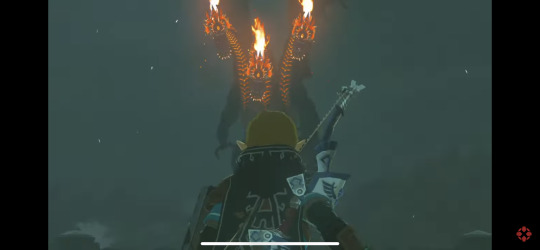
Idk about anyone else but I am most excited to fight Gleeok on this bridge!
#made this post on my main blog#it felt appropriate to share on this one too#tears of the kingdom#totk spoilers#gleeok
11 notes
·
View notes
Text
It's Been a Year: Let's Talk This Blog
Hey everyone, it's been awhile! Sorry for not keeping up with all of the Legend of Zelda news we've gotten in the last year since I last posted. This post will just be a quick run down of where I've been, and what my future plans are with this blog. So let's talk about it.
Fun fact about the creation of this blog: This whole thing started as a project for my Writer's at Work class. It was a class designed to teach us English majors about different careers and writing styles we could pursue after graduation. Our first lesson was over blog posts, and since I was already a long time tumblr user, I figured I would create a blog around my number one obsession: The Legend of Zelda.
Even though my love for the series has not diminished, I will say my relationship to this blog felt weirdly professional. Every post I made was for a grade, and there was certain criteria I had to meet. In the end, I passed the class and earned my degree as well as two writing certificates, but I didn't know what to do with my newfound freedom when it came to posting here. So between a small blog-identity crisis, writer's block, and my laptop breaking, I left this blog to rot.
When one of my friends managed to fix my laptop a few weeks back, part of me wanted to come back to this blog and continue posting. The problem was I didn't know what to post about. Nintendo must've realized my struggle though, because we have gotten quite a bit of news regarding Tears of the Kingdom recently.
So now what? I still have my original list of posts that I wanted to make, so while we wait for Tears of the Kingdom to drop, I'll be editing and posting some things that never made it past the first draft stage. Once I get the game in my hands, I will likely be live blogging important moments from my personal gameplay, as well as sharing my opinions on the game itself. The Twilight Princess manga is also just released it's final part, so once I get my hands on a copy of volume 11 I will be posting about that manga series as a whole.
Long story short, I miss this blog and I am excited to return and continue posting about my favorite series. I am also looking forward to posting in a format that I prefer, instead of following guidelines put in place while I was in class (5 paragraph limit, researching topics, etc.). Expect a lot more rambles, more frequent posts, and whatever else I think of.
2 notes
·
View notes
Text
Let's Talk Breath of the Wild

Duel released on the Wii U and the Switch on March 3, 2017, Breath of the Wild was the highly anticipated game said to flip what fans refer to as the "Zelda formula" on its head. With weapon durability, no set dungeon order, and character customization in the form of armor changes, many fans were excited for the change of pace, and newer fans were enticed by the completely open world concept. With multiple 10/10 scores from video game reviewers, Break of the Wild is no doubt a success, but there is a question I want to answer: Is this a good first game for people looking to get into The Legend of Zelda series? Let's talk about it.
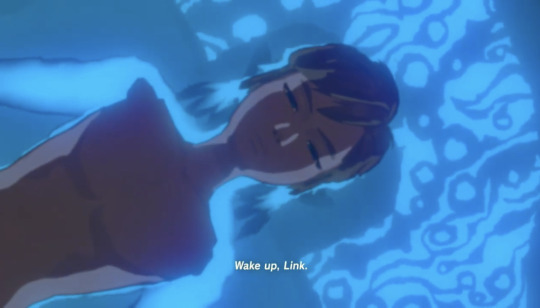
Despite claiming to go against the "Zelda formula," Breath of the Wild starts off just like most other Legend of Zelda games, with Link asleep and someone needing to wake him up. A mysterious voice calls out to him, and Link wakes up in a weird vat of water in a room that looks more like a cave. He is prompted to grab an object referred to as a Sheikah Slate and to follow the point on the map it provides. You have the option to take some old, worn out clothes from the cave and are introduced to some new controls, such as jumping and climbing, before running out into the open to get a proper look at the Kingdom of Hyrule in this time period.
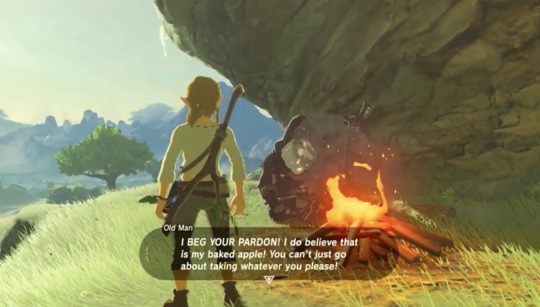
Going down the hill will lead you to an old man who only offers you vague information. You can steal his food, torch, and axe, but be aware that he will call you out for it. Newer fans, or those just wanting to get to the story will most likely listen to the voice reminding Link to head to the point on the Sheikah Slate, but older fans, or those who are more interesting in exploring may head to the run down Temple of Time. Following the mark will activate a cutscene where Link sets the Slate down on a pedestal and receives the warning "Watch out for falling rocks." The earth shakes, and suddenly all of these towers all around Hyrule begin to rise up out of the ground, including one right underneath Link.
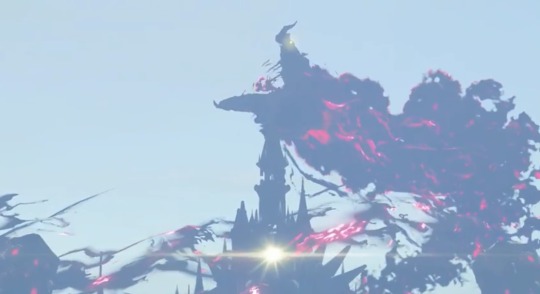
The voice that woke Link up originally speaks to him again, telling him that he has been asleep for the last 100 years. As she's speaking, the cutscene moves to show the final boss, Calamity Ganon, circling Hyrule Castle off in the distance. The voice begs Link to hurry and the cutscene ends. Rushing down the tower will result in either death (I cannot tell you how many times I fell off the tower the first time I played), or if you survive, the old man will warn you about the walls surrounding the Great Plateau and offer you his paraglider in exchange for some treasure from a glowing shrine. Each shrine he has Link visit gives you a new rune on the Sheikah Slate, as well as something known as a Spirit Orb, which you can exchange for either more stamina or another heart container at various Goddess statues around Hyrule.
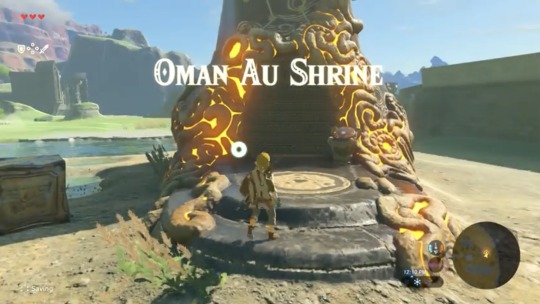
Once Link has all 4 of the Spirit Orbs that the old man wants, go back to the ruined Temple of Time to activate a cutscene with the old man that I will not disclose information about here because plot spoilers, but by the end of the cutscene he will give Link the paraglider as promised, opening up the rest of Hyrule to you to either explore or ignore if destroying Calamity Ganon is your only goal.
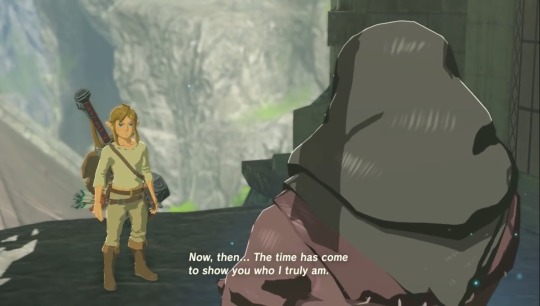
What I appreciate about Breath of the Wild's tutorial stage is how it doesn't feel like a tutorial. Yes, you're learning the game mechanics in a closed environment, but there are still plenty of dangers that can result in death if you're not careful. One wrong step off the tower, or running out of stamina and plummeting from a cliffside will result in that Game Over screen no one likes seeing. There is also a lot to explore on the Great Plateau, so you as a player have the option of speed running all of the requirements to leave ASAP, or you can take your time and try to find as many secrets as you can before continuing on to the rest of Hyrule. There's no rush here.
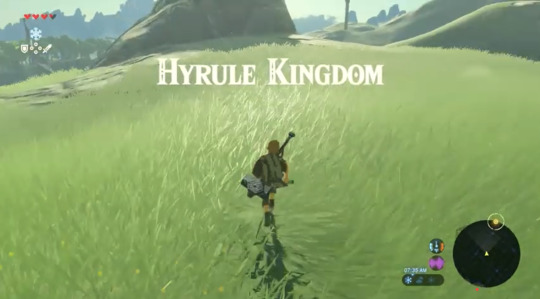
Now, do I think this is the best game to play first if you're looking to get into The Legend of Zelda series?
No.
Don't boo me just yet! Hear me out.
Breath of the Wild did an excellent job of bringing in new players to The Legend of Zelda franchise, I am not denying that. However, it is not the best representation of what a Zelda game is. It is beautiful, and engaging, and the open world aspect is fantastic, but if you are someone who is looking for a game that will give you an idea of what the rest of the series is like, this game will not do that. There are also a lot of call backs and references to previous games that you can only truly appreciate if you’ve played other games in the series first.

If this is the only game you have access to, or if you only care about playing this game and not anything else in the franchise, by all means, pick up your controller and go wild! This game is a blast whether you’re familiar with the series or not. But if I was trying to get someone into The Legend of Zelda as a whole, and trying to give them the best idea of what a Zelda game is like, this is not the one I would recommend first.
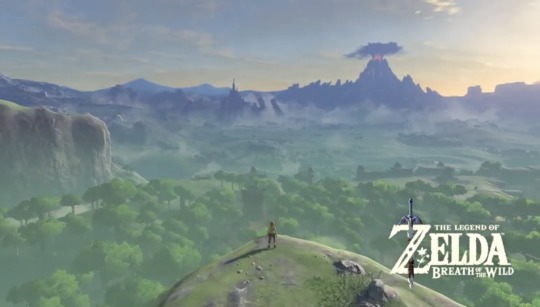
4 notes
·
View notes
Text
Languages and Alphabets in The Legend of Zelda
With summer break right around the corner for a lot of people, I figured now was the best time to share a fun project to keep you occupied: Learn a language.
No, this isn't a pitch to make you download Duolingo.
There are a handful of different alphabets to learn from The Legend of Zelda franchise, some of which follow the Japanese language system, and some that follow the English language system (if your native language still uses the Latin alphabet, you can use the ones that translate into English). I'm only going to focus on the Latin alphabet based ones for this post, but if you're curious about the Japanese based ones, look up the Hylian scripts from Ocarina of Time and Wind Waker.

The one I'm fluent in, and the one I recommend most people start with, is the Hylian script that comes from Twilight Princess (shown above). A lot of the letters, such as B, H, and S all have a similar look to their Latin counterparts. There are some weird ones, like A and M having a similar look to one another, but overall there isn't much to trip you up with this one. My best tip of advice is write your own key so you get used to seeing the letters in your handwriting, and then start translating text you are familiar with.

One that I tried to become fluent in and failed is another one based on the Latin alphabet, but instead of Hylian, it is the language of the Gerudo (shown above). While the Hylian in Twilight Princess has some Latin similarities, Gerudo gets a little tricky with the flowy letters. There are some letters that look similar enough to their Latin counterparts, such as B, L, and P, but then you have some that look like a completely different letter, such as U looking like the Latin F. If you're up for the challenge though, this script is fun to write out.

There is another Hylian script that we see in Skyward Sword (shown above) that is based on the Latin alphabet, but this one is a little harder to learn, the main reason being the repeating letters. You'll notice that D and W, G and Q, I and X, O and Z, and P and T share characters, so spelling and reading can be confusing. Memorizing these also comes with a similar challenge we see in the Gerudo language where some letters look like different Latin letters, such as K resembling the Latin J.

One of the more difficult Latin alphabet based languages comes from Breath of the Wild and it is the ancient Sheikah script (shown above). While it looks very nice in game, hand writing this language is a pain, and there are not many tips or tricks I have to offer in regards to learning it. The only letter that I would say looks close enough to its Latin counterpart is Z, but even then, it could be mistaken for the Latin S. The numbers 0-9 share too many similarities design wise, especially 0 and 5, and the punctuation looks like other letters or numbers. I'd say unless you've already learned the other Latin based languages, or unless you're obsessed with the Sheikah clan, I would hold off on this one.

If you want a language to learn from Breath of the Wild, I would suggest Hylian (shown above) over Sheikah. Warning, it is very similar to Skyward Sword's Hylian, but not all of the symbols are the same. Remember how K in Skyward Sword's Hylian resembled the Latin J? That same symbol is used here, only this time it really does mean J. There is still the issue of letters sharing symbols here too though, like E and W, F and R, J and T, and O and Z. Again, this can make it difficult for spelling and reading, but if you're stubborn, I say go for it!
Alright, that's five different alphabets to choose from. Like I said, I suggest starting with the Twilight Princess Hylian, but if one of the other ones intrigues you more, give that one a shot! I'm going to try and finally master Gerudo once my own summer break hits in 2 weeks. Let me know if you plan on trying any of these out, or if you've already mastered one, feel free to share your own advice to those just starting! And to those of you just starting- good luck!
56 notes
·
View notes
Text
My Legend of Zelda Timeline
I had a fun idea while working on the draft of a longer blog post that’ll come out in a few days. I wanted to create The Legend of Zelda timeline using the games I owned. The picture may be bad (I’m a writer, not a photographer for a reason) but I managed to capture every game in order. I had some small issues with multiple digital copies existing on my 3DS and Wii U, but by substituting in manga adaptations, I managed to fit every game and spin off that I own into one timeline.
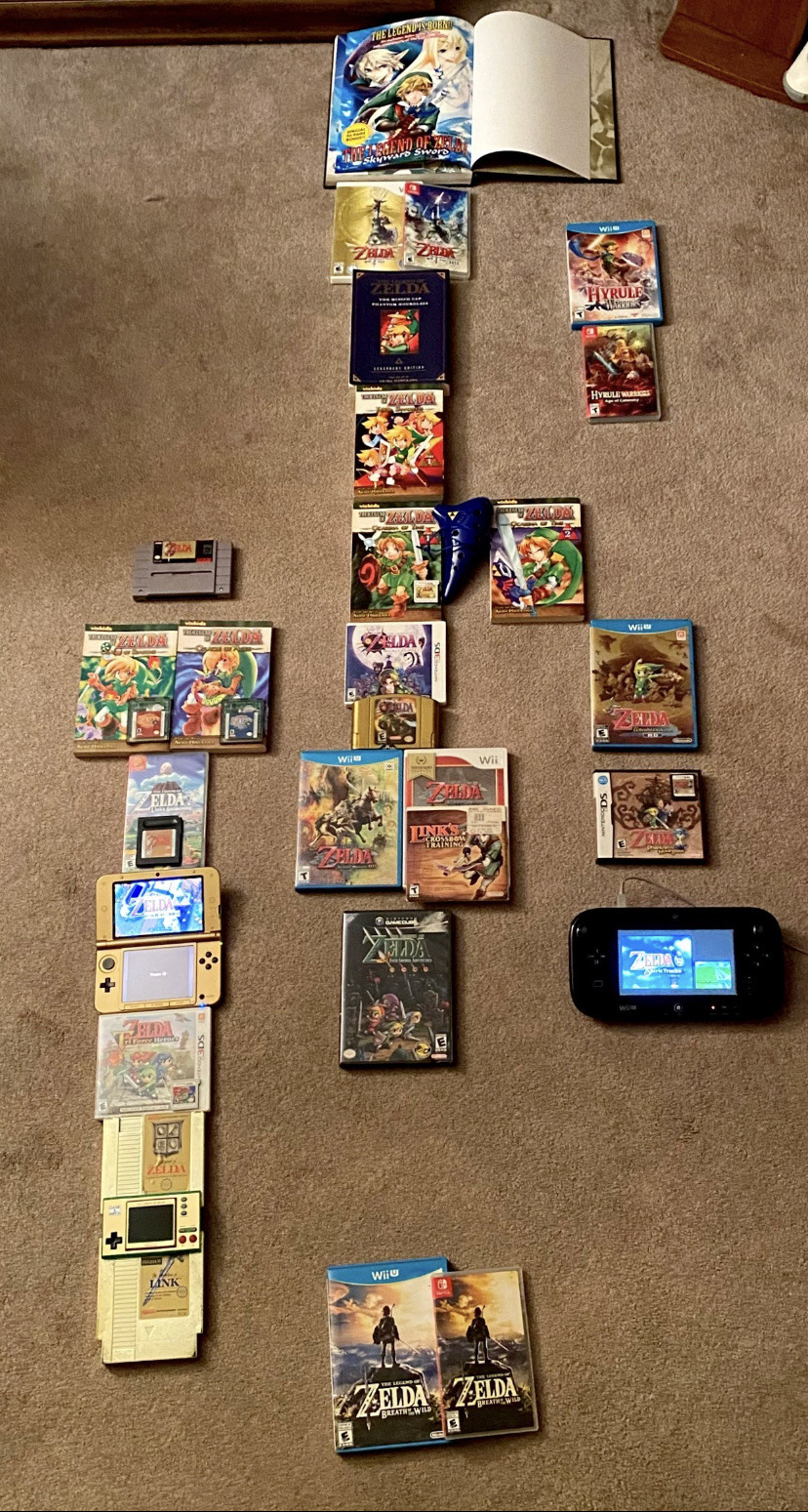
Was this a pain to organize? Yes. Despite that, I had a lot of fun putting this together! There are some pieces that I wanted to point out. My copy of A Link to the Past is the same cartridge that got me into this series back when I was 4, and Four Swords Adventures was the first game that I beat in this series. If you’re wondering about what’s above Skyward Sword, I decided to include the manga that Akira Himekawa wrote as a prequel to the game as well.
Now, this wasn’t just an excuse to show off my collection (this is hardly a fraction of it if I’m being honest). With this, I wanted to challenge other Legend of Zelda fans to create their own timelines too, whether that be with copies of the games, manga adaptations, fan art you drew for a specific game- any mix of Legend of Zelda media that you can turn into a timeline. It doesn’t have to be complete, I know it looks like a lot, but see what you can do and have fun with it!
5 notes
·
View notes
Text
Let’s Talk Skyward Sword
Originally released November 18, 2011 for the series’ 25th anniversary, and then rereleased in HD for the Switch July 16, 2021 for the series’ 35th anniversary, The Legend of Zelda Skyward Sword is a game that utilizes motion controls in order to make the player feel more involved in the gameplay. While ratings now place this game between a 4/5 and a 4.8/5, I remember this game being poorly received by the community back in 2011/2012, so why the high ratings now? Let’s talk about it.
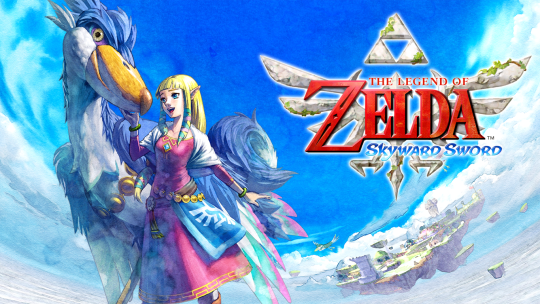
Skyward Sword starts off like how a lot of Legend of Zelda games do- Link fast asleep in his bed, and someone coming to wake him up so he can finally get started on that hero’s journey. Instead of being located in Hyrule though, we’re given the chance to explore the world above the clouds, Skyloft, where people fly around on giant birds known as Loftwings. The first issue Link must solve involves running around Slyloft looking for his missing bird. This is where we’re given the tutorial stage on how to climb, swing a sword using motion controls, and where we’re introduced to the colorful array of characters this floating island has to offer, including Link’s longtime friend, Zelda, and his longtime bully, Groose.

You’ll quickly find out that you’re not limited to just Skyloft for this game. After finding Link’s loftwing and winning a flying competition, Zelda rewards Link with a sailcloth, which works as a mini parachute to break your fall when jumping from extreme heights. In the middle of flying around with Zelda in a cutscene, a tornado strikes, knocking Link out while carrying Zelda to the surface below the clouds. When Link wakes again, he’s told by Zelda’s father, Gaepora, that she is gone.
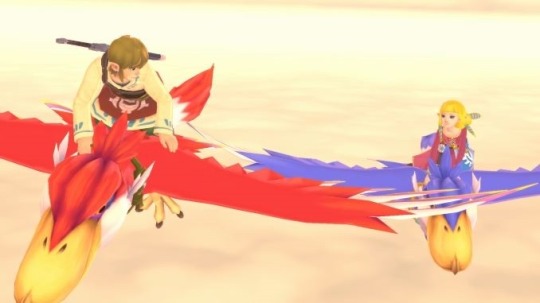
When Gaepora leaves, the cutscene ends and you’re free to continue exploring Skyloft at night. A spirit-looking figure will be waiting for Link out in the hallway, and following her to the Goddess Statue will reveal a sword in a stone. Draw the sword, and get thrown into another cutscene of Gaepora explaining the mysteries of the land beneath the clouds. Link promises to travel down to the surface to find Zelda, changes into the knight’s uniform (the classic green tunic and hat combo), and flies off on his loftwing to an opening in the clouds where he dives down, and the real journey begins.
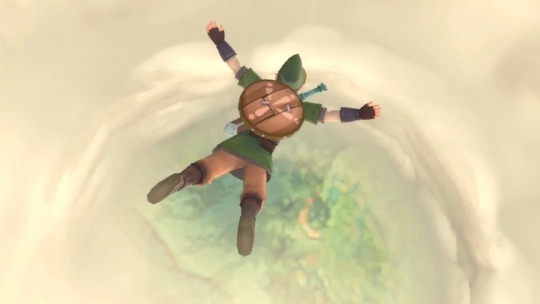
Alright, that was a lot for an opening section, but I think having a longer tutorial stage here works in the game’s favor. Skyward Sword relies heavily on motion controls (unless you’re playing the HD remake and turn them off). It’s not as easy as pressing a button anymore. You’re also not in a land that’s familiar to you. This isn’t Hyrule, this is Skyloft, a world above the clouds where if you’re not paying attention, you can just walk off the edge and plummet down into the clouds. Taking the time to get people used to the controls, having a stamina bar, and learning the area and the characters living there is not what I’d consider wasted time. Normally I hate long, drawn out tutorial stages (looking at you Twilight Princess), but here, I think it works, or at least makes sense.
Now why the poor reception initially? Two big things: the motion controls, and the world itself. Looking at games like Ocarina of Time or Twilight Princess where you’re able to run from one end of the map to another without having to go through drawn out cutscenes add to that open world feel of the games. Skyward Sword doesn’t have that. You can’t walk from the desert to Death Mountain to the forest. You have to fly to each area that you want to explore, and then are limited to that part of the map until you return to the skies. As for the motion controls, most people who played on the Wii reported problems with the Wii Motion+ not registering their movements. While I managed to get through the vast majority of the game with no issues, my Wii Motion+ stopped working right at the final boss fight, preventing me from ever truly beating the game. Thankfully the HD Switch version has resolved a lot of the issues with the motion controls, hence the newfound praise of the game.

Now do I recommend Skyward Sword? Yes, but depending on what you look for in a game, this might not be your favorite. It’s not my favorite, but it is high on my list, because I go into these games for the lore. I love fun characters and world building, so seeing the land of Hyrule before it became the kingdom we know and love was so exciting! Now, if you go into Legend of Zelda games for the open world exploration, this game might disappoint in that area. The sections of the world are creative and fun to explore, but it’s not a true open world. Even if the limited world exploration and the motion controls make you question how much you’ll get out of this game, I do suggest picking up Skyward Sword and at least trying it out. Get through the tutorial stage and go have fun exploring that first dungeon and fighting that first boss. The story carries this game, and it’s a memorable one that new fans can get into, and long time Zelda fans will appreciate.

4 notes
·
View notes
Text
Let's Talk the Ocarina of Time Manga
Written by manga duo under the pen name Akira Himekawa, the Ocarina of Time manga was published in Japan in 2000, and hit shelves in America in 2008. To adapt the story on paper, changes from the original game had to be made. I’m going to split this up by going over those changes to see what translated well on the page, and what should've stayed more faithful to the original game's story.
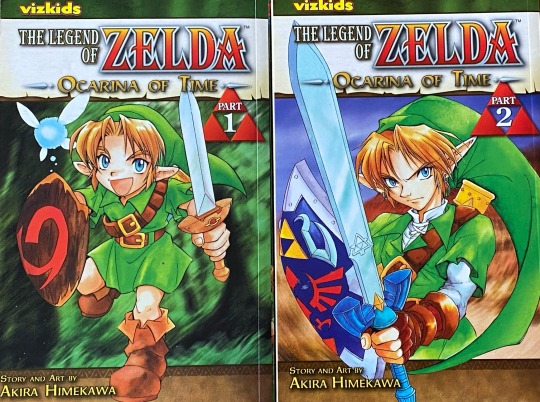
I will admit right off the bat that I may be biased in this post. My first introduction to Ocarina of Time was through the manga. I didn't have a way to play the game when I was younger, but my local library had all of The Legend of Zelda manga. That being said, both the game and the manga have a very special place in my heart. How well did Himekawa’s adaptation do though? This will contain spoilers for both parts of the manga, but if you’ve already read it, or don’t care about plot spoilers, then let’s talk about it.
The Good
Starting with the changes that work, Link building some of the early weapons and equipment himself was a great way to give us some insight on Link’s character. For a video game, Link’s personality is kept sort of vague, that was the player can put themselves in his shoes. For a manga though, you want to follow a protagonist that has a more recognizable personality. By showing us Link’s innovation in creating the slingshot, and his resourcefulness in carving the Deku shield, we start to see hero-like qualities that reassure us that Link will be just fine on his own once he leaves Kokiri Forest.
Continuing with the characters and their personalities, once Link makes it to Castle Town, instead of making a beeline for the castle, he runs into a young girl close to his age and spends the day playing with her under the promise that she’ll introduce him to Princess Zelda later. During this sequence, we’re shown all of the mini games and shops available in the game, and get to know this unnamed character a little bit more. Their night ends with Gerudo thieves attempting to rob the girl, leaving Link to chase them off. The girl is revealed to be Zelda when Impa comes up to escort her back to the castle safely. She accidentally drops the Ocarina of Time, which Link picks up and holds onto in the hopes of returning it to her.
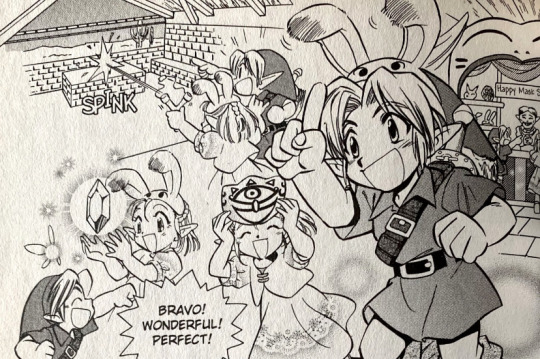
Something that we don’t get in the game is an early introduction between the people who will end up being the three holders of the Triforce. The manga remedies this by having Ganondorf interrupt Link and Zelda’s meeting in the garden by introducing himself. This gives us more of an insight on Zelda’s personality as well, where she tells him to leave, standing up to the King of the Gerudo, despite being a child still.
The rest of the plot that follows Link going on a quest to collect the sacred stones sticks pretty close to the in game events, but when he returns to Castle Town and sees it up in flames, instead of just standing there watching during a cut scene, Link rushes into the burning town, again showing us his heroic personality. Even though he’s unable to do much, he still faces the danger head on. While Link is fighting in the town, we get a shift of perspective to see Ganondorf having cornered Zelda and Impa. While they manage to escape like normal, Link attempts to attack Ganondorf directly. Even though he looses, that small fight gives us a starting point for Link’s power compared to Ganondorf’s, and gets readers invested on Link’s upcoming journey to grow stronger.

The manga continues to follow the plot of the game with Link sleeping for 7 years, but instead of waking up and meeting Sheik in the Temple of Time, Link is alone in the Temple. Sheik isn’t introduced until the Fire Temple, where he saves Link after the Hero of Time fails to defeat Volvagia. Delaying this introduction gives us a more impactful meeting between Link and Sheik, where Sheik still comes off as mysterious, while still giving Link a reason to trust him.
The game strictly follows Link’s point of view, since he is the character the player is using to navigate through Hyrule. With the manga though, we’re granted the opportunity to see scenes without Link, which gives us one of my favorite plot points in the two book series: Sheik secretly working for Ganondorf. This adds tension to the plot, since Sheik is working with Link directly. While the Hero has no reason to doubt Sheik, since he saved his life back at the Fire Temple, readers are left wondering how this will all play out.
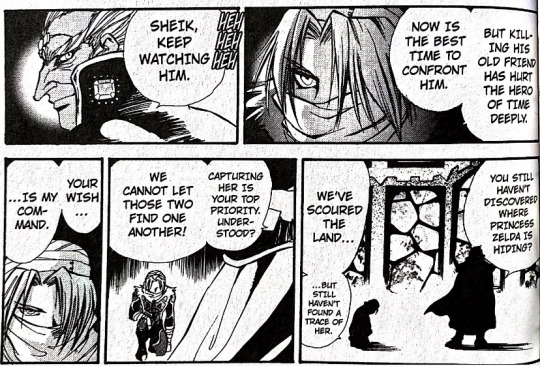
Impa’s character also gets a lot more attention in the manga adaptation. While we see Link’s progress in the game grow by collecting more heart containers, it’s difficult to translate that onto paper. Himekawa’s solution? Training montage in Kakariko village with Impa! We see Link actually take the time to learn combat from Zelda’s former bodyguard, ending with her piercing Link’s ears to signify that he’s reached adulthood according to Sheikah tradition.
Book 2 of the manga series gives us a fight at Lon Lon Ranch, where Link has to fight to rescue Malon from a brainwashed Ingo and several Gerudo guards. Sheik comes in to help as well during this fight, and we’re given a daring escape on Epona. While the moment is taken from the game, the manga adaptation adds a lot more action to the scene, which I feel could’ve been part of the game, but was a missed opportunity that the manga decided to fill in.

The next big change is Link’s journey through the Gerudo Desert. The journey to the Spirit Temple is my favorite moment in the manga, with Sheik helping to guide Link through the desert, only to betray him once the Gerudo warriors show up, giving us that payoff to the discovery that Sheik had secretly been working with Ganondorf the whole time. People who have played the game might’ve been confused at this moment, but Sheik’s betrayal doesn’t last long. He apologies to Link later on, claiming that he never truly supported Ganondorf, and helps him fight off the twin witches, Kotake and Koume. Sheik gets injured during the battle though, forcing Link to retreat to the Spirit Temple with the Sheikah.
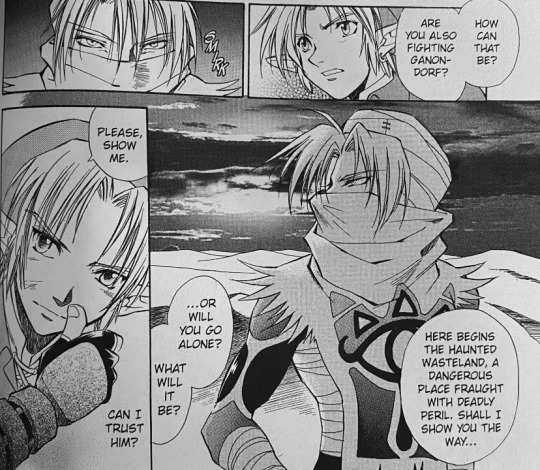
The final events before Ganondorf’s Castle take place in the Spirit Temple, which really helps with pacing. Instead of traveling all the way back to the Temple of Time, it’s revealed that Sheik was Zelda the whole time at the Spirit Temple, followed by Ganondorf kidnapping the Princess of Hyrule. While a reveal in the Temple of Time brings things around full circle in the game, the dramatic moment happening in the Spirit Temple in the manga helps keep that adrenaline rush from the previous battle going without dragging through another journey across Hyrule.
The last big change that I believe really adds to the story may seem small in retrospect, but it is a scene that has stuck in my head ever since I first read the series. During the fight against Ganon, the Master Sword gets knocked from Link’s hand just like it does in the game. This time though, instead of Link running to grab it himself, Zelda picks up the Master Sword and throws it over to him. It’s such a small detail, but puts Zelda in the fight, and shows us that determined spirit of hers that we saw back at the beginning of the manga.

The Bad
Not all changes in the adaptation were positive. I mentioned above how Zelda drops the Ocarina of Time in Castle Town while playing with Link. While that entire scene is very well done, her dropping the ocarina feels sloppy. After being attacked by Gerudo thieves, you’d think that she would double check that she still has the Ocarina of Time on her before leaving with Impa. I could see the argument that she dropped it on purpose for Link to find, but the manga doesn’t make that clear, and even if that was the case, with all of the thieves in town, it’s not a great plan.
Now this might get some backlash from other fans of the manga. I don’t like Link’s backstory with Volvagia. The boss of the Fire Temple was already badass in the game, being a dragon that lived inside Death Mountain who was resurrected by Ganondorf to keep the Gorons under control. The flashback of Link purchasing a baby dragon as a child and freeing him felt shoehorned in. Maybe if we got that scene when it happened instead of a flashback, I would’ve appreciated it a little more, but as it stands, it feels like a cheap shot to get an emotional reaction from readers. I’m all for crying over an impactful death, but Volvagia didn’t need to be a sympathetic villain brainwashed by Ganondorf. Just let the evil dragon be an evil dragon.
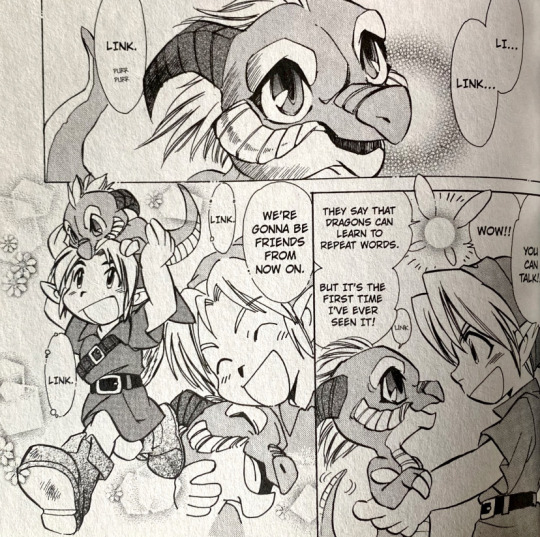
Fighting Dark Link in the Water Temple is an iconic moment in the game that people still talk about to this day. You’re in a room with shallow water, a single dead tree, and all you’re told is “Conquer Yourself.” It’s chilling to watch Link battle his shadow, and struggle against a creature that can perfectly copy his movements. In the manga though, Dark Link is a spirit that rises up out of the well in Kakariko, replacing the Bongo Bongo, the boss of the Shadow Temple. This change could’ve been great! Link fighting his shadow in the shadow temple makes sense, but we never see the Shadow Temple in the manga. Instead, the fight takes place in the middle of Kakariko, with Impa and the rest of the town watching. It feels like a side show moment. Maybe it’s just me, but I feel moments where a character has to fight an evil version of themselves should be private battles. It’s personal, but we don’t get to see that conflict of Link fighting himself in the manga. Instead we get Impa giving him advice as he’s fighting, and the town cheering when he wins.
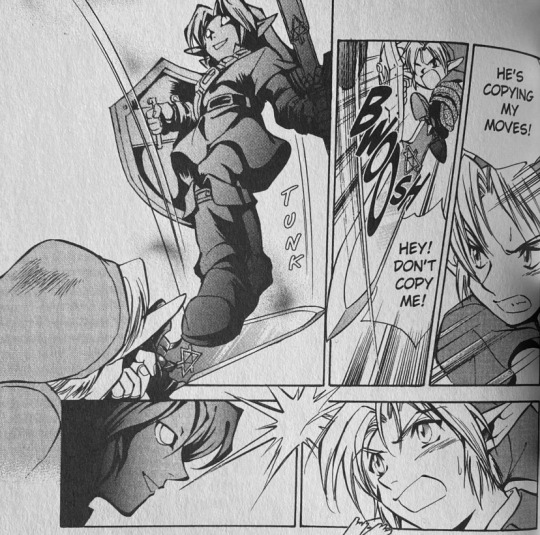
The last change that bothered me was Nabooru’s whole character. There’s no time travel back and forth between young and adult Link in the manga, which is fine. That plot point would’ve been difficult to cram into a 2 book series. However, Nabooru’s character feels like a joke in the Spirit Temple. Instead of being a rebellious second in command who secretly plots against Ganondorf, she reads more like a goofy thief. Nabooru isn’t even aware of the fact that she’s a Sage until the last minute before Link storms Ganondorf’s Castle. She has a few badass moments in the manga, but I felt like her character wasn’t taken as seriously as it should’ve been.
Conclusion
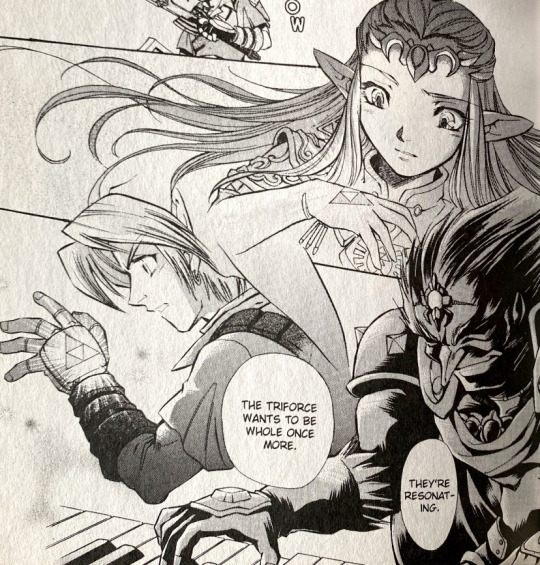
There are a bunch of other changes in the manga that I didn't have much of an opinion on one way or another, but overall, and I know this is probably a controversial statement, I believe the manga handled the character aspect of Ocarina of Time much better. The plot could feel rushed at times, having only 2 books to the tell the story, but the characters feel like real people with goals and fears. People get confused when I say Sheik is my favorite Legend of Zelda character overall, and I always point them to Himekawa’s adaptation to explain myself.
I know I mentioned my bias towards the manga, since that was my introduction to Ocarina of Time, but I'm curious on how well received this manga is for people who played the game first. For those of you who played the game first, or even those who prefer the game over the manga, what parts worked for you, and what parts didn't? I know growing up I loved the Volvagia backstory, but looking at it now, it feels awkwardly thrown in.
And don’t forget, all of this is just my opinion! You’re free to love or hate the manga, but if you’re a fan of The Legend of Zelda franchise and haven’t picked it up, I’d suggest giving it a chance. Who knows? You might be pleasantly surprised despite the changes.
16 notes
·
View notes
Text
Let's Talk about The Legend of Zelda Game & Watch
This past Christmas, one of my good friends gifted me a Legend of Zelda Game & Watch. Released on November 12, 2021, the small handheld device contains the original Legend of Zelda, Zelda II: The Adventure of Link, and Link's Awakening, as well as the Game & Watch game, Vermin, and a timer game where you continuously fight a hoard of enemies. With a price tag of $49.99 though, some of you might be wondering "Is it worth it?" Let's talk about it.
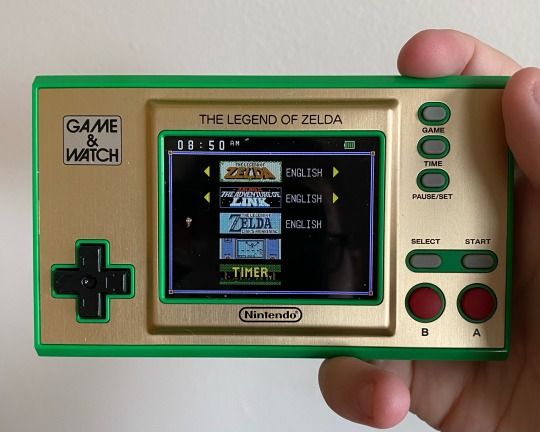
Starting off with the good, the battery life on the device is way better than I expected. While I couldn't find an official statement on how long the battery is expected to last, most people have been saying between 5-8 hours depending on how bright the screen is.
Another positive I want to mention is the convenience. The Legend of Zelda Game & Watch is smaller than my iPhone 11, and fits in my bag or pocket, making it great for on the go when I don't feel like carrying my 3DS or Switch around. I will admit though, I couldn't figure out how to adjust the volume at first, so I did avoid taking it out in public, but hitting the "Pause/Set" button allows you to adjust both the screen brightness and the volume.
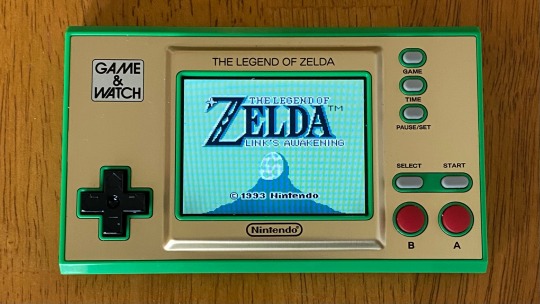
Something else I feel like I should mention is the language options. All three Zelda titles are available in both English and Japanese, and Link's Awakening is also available in French and German as well. Just so you're aware though, the version of Link's Awakening on the Game & Watch is the original black and white version released in 1993 for the Game Boy.
Now onto the things that aren't as great, starting with the audio. The audio quality itself is not the issue, all of the music is in 8-bit, so it's hard to mess that up. The complaint I have is the lack of a headphone jack. While not figuring out how to adjust the audio was my own stupid self's fault, the lack of a headphone jack makes taking this device out in public difficult to play while being respectful of those around you. Sure, you can play on mute, or simply not give a fuck and blast the music for everyone to hear, but I feel having that option to wear headphones would've been a nice addition.

The biggest downside I will say is the price. The three Zelda titles available can all be downloaded for less than $10 each on the Wii-U and/or 3DS e-shop. For those of you with a Switch online membership, The Legend of Zelda and Zelda II are both available for free through the NES Online download. While the Timer game and the Game & Watch themed game are things only available on the device itself, I have a difficult time saying they add any real value to the handheld.
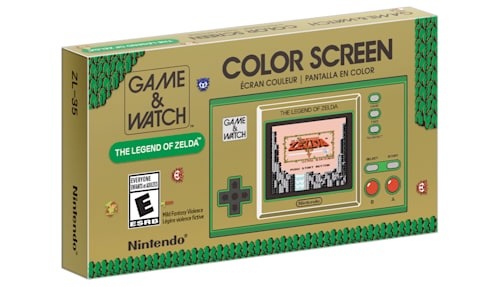
For any collectors or dedicated Legend of Zelda fans, I would recommend getting your hands on a Legend of Zelda Game & Watch. It's a convenient handheld device that allows you to take three classic titles on the go. For the casual fan though, I would say the $50 price tag isn't worth it. If you're just looking to play through the games, I'd suggest either downloading them off of the e-shop, playing them on your Switch, or hell, emulate them. I can't stop you. I have Zelda II downloaded on my laptop. Just don't waste your money on this if all you care about is playing through the games. I love my Legend of Zelda Game & Watch, but it is not a handheld I'd recommend for everyone out there.
4 notes
·
View notes
Text
Breath of the Wild 2- Pushed Back to 2023
Last week on March 29, 2022, Nintendo released an update regarding the long awaited sequel to The Legend of Zelda Breath of the Wild, currently referred to as Breath of the Wild 2. The game was expected to launch this winter, but Eiji Aonuma, the project manager for The Legend of Zelda series, let us know that the game will not be available until Spring 2023. Since Breath of the Wild came out back in March 2017, that puts 6 years in between games.
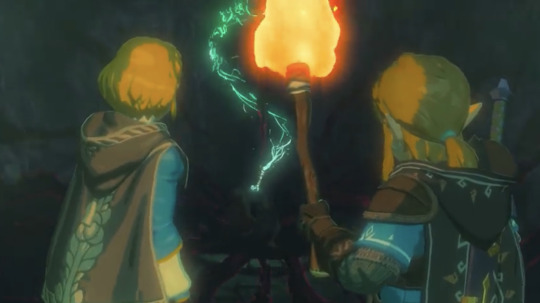
As an avid Legend of Zelda fan who has been desperately waiting for this game since it was first announced back in 2019, I have some opinions on this setback.
I’m so happy.
Did you expect anger from me? Annoyance? Guys, this is The Legend of Zelda- release dates getting pushed back is a normal thing, and to be expected. If you’re new to this franchise, you might not be used to delays like this, but I’m warning you now, this is pretty standard. As much as I want to get my hands on this game, I would rather wait for a polished game than be sold a rushed game full of glitches and issues that hinder the gameplay experience.
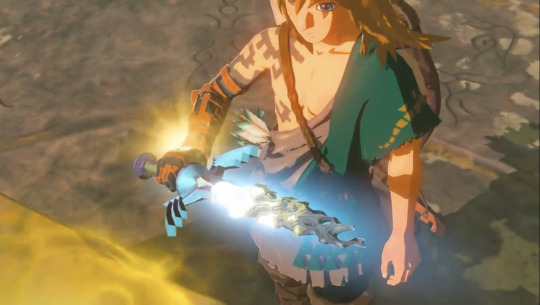
Now, it’s okay to be upset about this news. As happy as I am, I will admit that waiting does suck. For anyone disappointed about this pushback, let me point to towards Skyward Sword HD on the Switch. Based on the broken image of the Master Sword shown in the new Breath of the Wild 2 announcement, and the return to the sky plot line Nintendo keeps mentioning, I think it’s safe to assume that references will be made to Skyward Sword’s story in this new game. It’s no accident that Nintendo remade the game for the Switch, making the Wii original title from 2011 more readily available to newer fans.
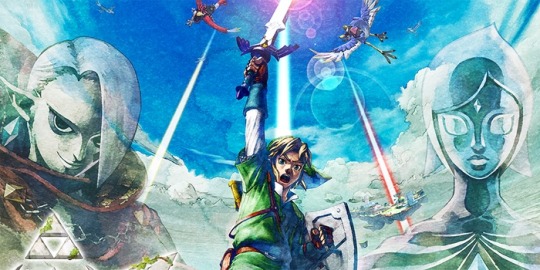
Until next spring, I will be eagerly awaiting Breath of the Wild 2, catching up on the other Legend of Zelda games on my Switch, and following Nintendo updates closely for any crumb of information they have to give us regarding this franchise.
40 notes
·
View notes
Text
I tried finding an answer as to why Majora's Mask wasn't given a higher rating originally, and while I couldn't find anything specific, it is likely that the E and then E10+ ratings were to coincide with Ocarina of Time's ESRB ratings, which were E on the N64, and then E10+ for the 3DS remake. Since Majora's Mask is a direct sequel that was released only 2 years after Ocarina of Time, my best assumption is they didn't want to give the games different ratings that way younger fans would be able to play both.
That is just my best guess though.
Majora’s Mask: From E to T
Ocarina of Time was an instant classic from the moment it hit shelves in 1998, so it wasn’t a surprise when a direct sequel following the Hero of Time was released for the N64 in 2000. What was a surprise was the rating slapped on the cartridge.
Entertainment Software Rating Board, more commonly known as ESRB, was founded in 1994 and provides 6 levels of ratings for video games in the USA, Canada, and Mexico. The 6 ESRB ratings include Early Childhood (EC), Everyone (E), Everyone 10+ (E 10+), Teen (T), Mature (M), and Adults Only (AO). You might also see RP on a game, but that stands for Rating Pending, and will eventually be replaced with one of the 6 ratings listed above.
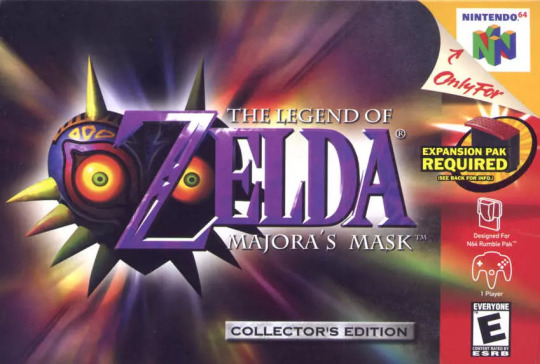
Majora’s Mask was rated E for everyone, meaning the content in the game is suitable for children ages 6 and up. Anyone who has ever played or even just watched the first few minutes would know that rating isn’t quite right. Between frightening imagery with Link being transformed into a Deku scrub, and the knowledge that the world is going to end and everyone is going to die in 3 days, it’s safe to say this game isn’t one you’d buy for a 6 year old.
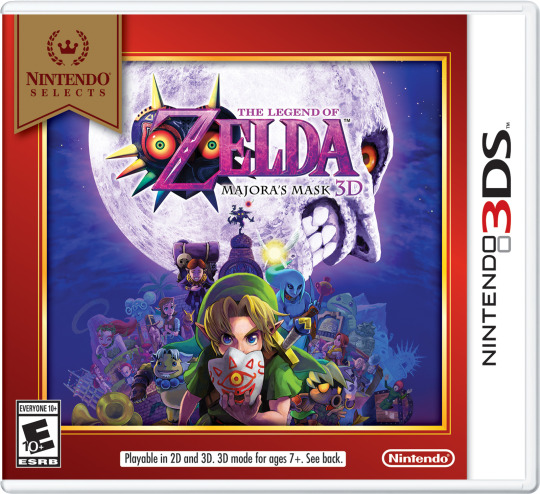
In 2015, Majora’s Mask was remade for the 3DS and the rating was changed. No longer E, the game was elevated to E 10+, meaning the content was suitable for kids ages 10 and up (the 7+ mention on the bottom of the image above is in reference to the 3D mode on the 3DS, not the game itself). Don’t let the bright colors in the artwork and gameplay fool you though. While the new rating was better than the old E rating, there were still those that argued that the rating wasn’t high enough, especially with the updated graphics adding more detail to the disturbing imagery.
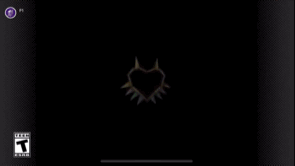
A few days ago, on February 25, 2022, Majora’s Mask was added to Nintendo’s Switch Online N64 pack, this time with another new rating: T for Teen. Before that, the only other main series title to hold a T rating was Twilight Princess, released in 2006 on the GameCube and Wii, and rereleased in HD on the Wii U in 2016. Many fans, myself included, argued that Majora’s Mask should’ve received a higher rating as well, due to the themes of death and end of the world catastrophes, on top of the disturbing imagery from using the transformation masks and the moon crashing down on Termina.
While I am pleased Majora’s Mask is finally getting the rating it deserves, I wonder if changing a game’s rating 22 years after its initial release will make much of a difference, or if the younger generation of Legend of Zelda fans will grab their joy cons and play through this disturbing classic without so much as a second thought about what they’re getting into?
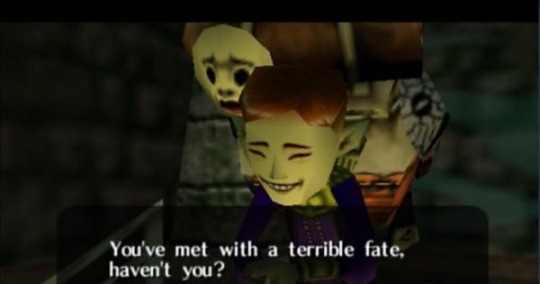
33 notes
·
View notes
Text
Majora’s Mask: From E to T
Ocarina of Time was an instant classic from the moment it hit shelves in 1998, so it wasn’t a surprise when a direct sequel following the Hero of Time was released for the N64 in 2000. What was a surprise was the rating slapped on the cartridge.
Entertainment Software Rating Board, more commonly known as ESRB, was founded in 1994 and provides 6 levels of ratings for video games in the USA, Canada, and Mexico. The 6 ESRB ratings include Early Childhood (EC), Everyone (E), Everyone 10+ (E 10+), Teen (T), Mature (M), and Adults Only (AO). You might also see RP on a game, but that stands for Rating Pending, and will eventually be replaced with one of the 6 ratings listed above.

Majora’s Mask was rated E for everyone, meaning the content in the game is suitable for children ages 6 and up. Anyone who has ever played or even just watched the first few minutes would know that rating isn’t quite right. Between frightening imagery with Link being transformed into a Deku scrub, and the knowledge that the world is going to end and everyone is going to die in 3 days, it’s safe to say this game isn’t one you’d buy for a 6 year old.

In 2015, Majora’s Mask was remade for the 3DS and the rating was changed. No longer E, the game was elevated to E 10+, meaning the content was suitable for kids ages 10 and up (the 7+ mention on the bottom of the image above is in reference to the 3D mode on the 3DS, not the game itself). Don’t let the bright colors in the artwork and gameplay fool you though. While the new rating was better than the old E rating, there were still those that argued that the rating wasn’t high enough, especially with the updated graphics adding more detail to the disturbing imagery.

A few days ago, on February 25, 2022, Majora’s Mask was added to Nintendo’s Switch Online N64 pack, this time with another new rating: T for Teen. Before that, the only other main series title to hold a T rating was Twilight Princess, released in 2006 on the GameCube and Wii, and rereleased in HD on the Wii U in 2016. Many fans, myself included, argued that Majora’s Mask should’ve received a higher rating as well, due to the themes of death and end of the world catastrophes, on top of the disturbing imagery from using the transformation masks and the moon crashing down on Termina.
While I am pleased Majora’s Mask is finally getting the rating it deserves, I wonder if changing a game’s rating 22 years after its initial release will make much of a difference, or if the younger generation of Legend of Zelda fans will grab their joy cons and play through this disturbing classic without so much as a second thought about what they’re getting into?

33 notes
·
View notes
Text
Walkthroughs and Why You Should Use Them
I was around 8 years old when I found a golden NES cartridge for fifty cents at a garage sale with the title The Legend of Zelda. This was back when I still thought the main character’s name was Zelda, and back before I knew there were multiple games in the series. My assumption when I picked up that cartridge was that I was going to be able to play A Link to the Past (the only other Legend of Zelda game I had been exposed to at the time) at home on my NES. Of course, after loading the game up, I quickly realized that wasn’t the case.
I’m 23 now, and despite the original Legend of Zelda being one of the first games I got my hands on, I only managed to beat it for the first time a few months ago. The furthest I had ever gotten in that game was the third dungeon, and even then I’d argue I found my way there by sheer luck. When I sat down a few months ago and decided that I wanted to play through the game, I was determined to see how far I could go on my own. I got horribly lost looking for a bracelet around dungeon 4 or 5 and ended up in Ganon’s dungeon. After that moment, I realized I had to set my pride aside and do something I hadn’t done in years: Pull up a walkthrough.
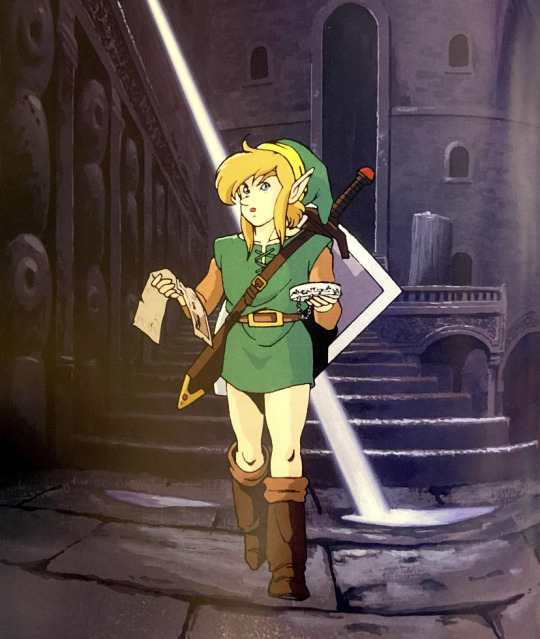
There are a few ways you can access a walkthrough. If you’re the type of person who’s more of a visual and/or audio learner, then I would suggest going the video route. There’s a difference between a playthrough and a walkthrough though, so be careful when looking up what you want. Playthroughs focus more on entertainment, and don’t always cover everything in the game and may use glitches depending on if its a speed-run, whereas walkthroughs focus more on completing the game and getting every little secret. If you are planning on playing a game while following a walkthrough though, I would suggest either a walkthrough book, or an online forum.
If you need a walkthrough for any Legend of Zelda game, I suggest checking out zeldadungeon.net. Their walkthroughs are easy to follow and organized in a way where you don’t have to scroll mindlessly to find the specific answer to one puzzle in a late game dungeon. The link above is the walkthrough I used to beat The Legend of Zelda back in August 2021, but they have walkthroughs for every game up to Breath of the Wild.
My main point here is that the point of playing a video game is to have fun. That stance can be applied to any game, whether it’s The Legend of Zelda, Metroid, Fire Emblem- any game you play should be fun to play. Getting stuck on a puzzle or getting lost in the over-world can tank that fun pretty quick, so don’t feel ashamed pulling up a walkthrough. Even if you’ve played the game a thousand times and poured hundreds of hours into it, we all forget things. If you feel stuck, look it up, and don’t let anyone tell you you’re less of a gamer for doing so.

15 notes
·
View notes
Text
Order of Play: Timeline Order
New fan wondering where the hell to start in a series that's been going on for 36 years, or a long time fan looking for a fun way to play through the games? While I'd argue there's no wrong way to get into The Legend of Zelda franchise, I'm going to break down a few ways I'd suggest playing through the games, starting with the confusing, yet still fun timeline order.
What's so confusing about timeline order you ask? Most veteran Zelda players understand- the story of the games does not go in release order, and after the fourth game in the timeline, Ocarina of Time, the timeline splits into 3 different paths. If you're following timeline order, you can pick and choose how you want to handle the split, but I'll go over some suggestions for the smoothest story order.
Buckle up, we've got 19 main titles to get through, and even a few spinoffs.

The first 4 games are pretty easy to follow. To follow timeline order, start with Skyward Sword, either the 2011 version on the Wii, or the recent HD remake on the Switch that dropped in 2021 (I'd recommend the Switch copy personally due to better motion controls, as well as the ability to turn off motion controls all together).
The Minish Cap comes next, which you can get a physical copy on the Game Boy Advance or a digital copy off of the Wii U e-shop (Warning- Wii U e-shop does close in March 2023 so get it while you still can- or emulate it if you're able to). Sticking with Game Boy Advance games, Four Swords comes next in the timeline. I did say that the first four games are pretty straight forward, but Four Swords is a little odd. For the Game Boy Advance version, you'd have to purchase A Link to the Past with the Four Swords game attached to it (it was a two games in one cartridge situation). The downside to playing the GBA version though is it does require you to play it as a multiplayer, so unless you have a friend with the game too, and a link cable, you won’t be able to play. There was a digital version available on the 3DS e-shop that allowed for single player use, however it is no longer available there. Again, I'd suggest emulating, or even in this case just watching a play through of Four Swords, since it is harder to get your hands on compared to other games in the franchise.

The last game in the starting timeline section is the one that breaks it all: Ocarina of Time. Considered by many as the best game in the series, Ocarina of Time is thankfully available on multiple platforms, including the N64, the Wii U e-shop (until March 2023), and the Switch N64 Online package. For those who prefer updated graphics and controls, there is even a remake of the game for the 3DS. However, since this is where the timeline splits, I'm going to suggest something a little weird: Play Ocarina of Time, and when you get to the final boss fight against Ganondorf, die. Save the game, let him kill Link, and then set the controller down. Now pick up A Link to the Past, the first game in the Defeated Hero timeline.
Yes, you heard that right, the Defeated Hero timeline. Nintendo created a timeline where the hero, Link, fails. Get comfy here, because the Defeated Hero timeline has the most games in it.
After A Link to the Past (which is available on the SNES, Game Boy Advance, Wii U and 3DS e-shops until March 2023, and the Switch's SNES Online membership) things stay confusing. The official timeline can't decide if Link's Awakening or the Oracle games comes next. It doesn't matter that much in all honesty, so I'd suggest playing them in whatever order you can get them. Link's Awakening might be the easiest to get ahold of, since it was recently remade for the Switch, but it is also available on the original Game Boy and Game Boy Color, as well as the 3DS e-shop (until March 2023). Oracle of Seasons and Oracle of Ages are also available for the Game Boy Color, but I'd suggest buying them on the 3DS e-shop while you still can (March 2023).

I hope you enjoyed A Link to the Past, because you'll be returning to that version of Hyrule for the next game, in the timeline, A Link Between Worlds. This is not a direct sequel though. The story takes place 100 years after A Link to the Past, with a different Link and Princess Zelda. Available on the 3DS, this game is pretty easy compared to other games in the Defeated Hero timeline, so consider this a nice break. Well, this and Triforce Heroes, the next game in the timeline, and another 3DS title.
Right towards the end of the Defeated Hero timeline, you're finally at the first game released: The Legend of Zelda. Available on the NES, the Wii U digital e-shop, the 3DS digital e-shop (both until, you guessed it, March 2023), and the Switch's NES Online membership, this game is not hard to get a copy of. Be careful not to name yourself Zelda though, unless you want to do the second quest which is notably much harder. Still not as difficult as the last game on the Defeated Hero timeline.
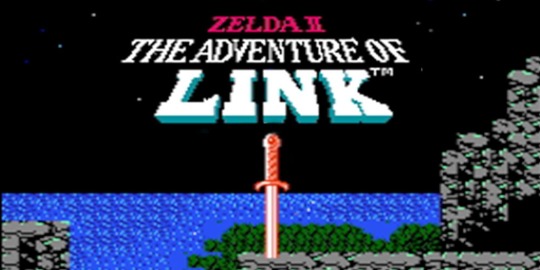
Zelda II: The Adventure of Link is easily the hardest game in the franchise, and is more of a side-scroller than a top-down perspective adventure. Available on all of the same systems as the original Legend of Zelda, Zelda II is easy to get your hands on, but not as easy to complete (I cannot tell you how many times I died playing through the first dungeon alone).
Remember how I said to die in Ocarina of Time? Boot that game back up and kick Ganon's ass. Beating Ocarina of Time splits the timeline again, and spoilers for a 24 year old game, but Zelda sending Link back in time creates a timeline where he continues his life as a child, and one where the hero no longer exists, due to him being sent back in time.
Confused yet? There's a reason why I said things can be confusing playing in timeline order.

We're going to follow the child timeline next, since the next game in that order follows the same Link from Ocarina of Time. The first game in the child timeline is Majora's Mask, which is available on all of the same consoles as Ocarina of Time, including it's own 3DS remake. Only thing is, if you're going to play it on the N64, you will need the expansion pack for the console itself in order to play.

The second game in the child timeline takes place about 100 years after the events of Majora's Mask. The only main series T-rated Legend of Zelda title so far, Twilight Princess. Duel released on the GameCube and Wii back in 2006, and then released again as an HD remake in 2016 for the Wii U, Twilight Princess continues with the darker story themes introduced in Majora's Mask. For all of my fellow left-handed people out there, I highly recommend either the GameCube or the Wii U version over the Wii (I struggled with the right-handed motion controls the Wii forced me to use, but have been doing much better with the left-handed Wii U combat).
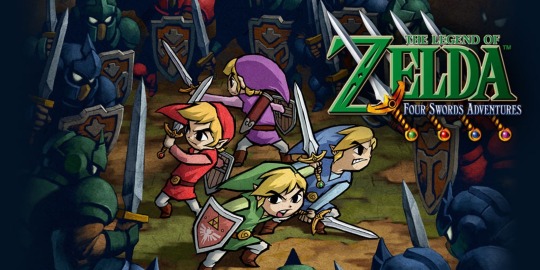
The last game in the child timeline is Four Swords Adventures. Available only on the GameCube, this game is another difficult one to get your hands on if you don't own a GameCube or Wii, so if possible, I'd suggest emulating it, watching a playthrough, or even picking up the two-part Four Swords manga as a solid substitute. I will say though, Four Swords Adventures is one of my favorite Legend of Zelda games gameplay wise, so if you have a system to do so, I highly suggest playing through it.
Remember that timeline Link abandoned after Zelda sent him back in time at the end of Ocarina of Time? If you're wondering how it's doing without a hero, let me be the first to tell you that all of Hyrule is now underwater in the forgotten Adult timeline.
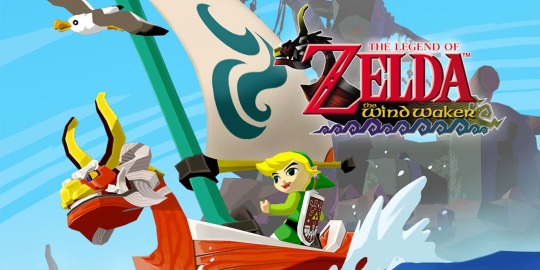
Wind Waker sends Link on a journey on the Great Sea, sailing around on a boat to explore the islands that still exist after Hyrule flooded. Available on the GameCube, and also released as an HD remake on the Wii U, this cartoon style game had mixed reactions at the time of it's release, but has since grown into a classic Legend of Zelda title that earned itself a direct sequel: Phantom Hourglass. Available on the DS and the Wii U e-shop (you already know what I'm going to say- until March 2023), this is actually one game I'd recommend getting the DS version of if possible for my left-handed folks. The Wii U digital copy is cheaper, but all of the screen options that focus on using the stylus are for right-handed people.
My same advice goes for those needing a copy of the final game in the adult timeline, Spirit Tracks. Just like Phantom Hourglass, this game is available on both the DS and the Wii U e-shop (until March 2023). However, the DS copy of this game usually runs higher than Phantom Hourglass, so I'd suggest getting the Wii U version if money if your main worry and just adapting to the screen setup (That's what I'm doing because I'm a broke college student, and it's working fine).

Three timeline splits and 18 out of the 19 main series games down and I can hear you all asking "But Rose, where is Breath of the Wild?" It's here at the end of every timeline. I'm not kidding, Nintendo couldn't figure out where it fit, so they threw it at the end of every timeline. Honestly though, saving Breath of the Wild for last is probably the best if you're trying to get into The Legend of Zelda franchise, since it is so different gameplay wise to any other Zelda game. It's available on both the Wii U and the Switch (I've played it on both, apart from some slight lagging issues in puddles on the Wii U version, both work really well).
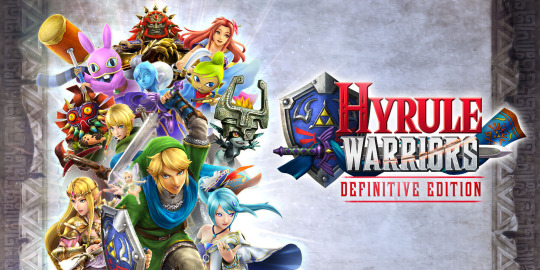
I mentioned two spins offs, and those are Hyrule Warriors and Hyrule Warriors 2: Age of Calamity. For Hyrule Warriors, I would suggest getting the Definitive Edition, since it includes everything from both the Wii U and 3DS versions of the game (available on the Switch). Based on the collection of characters in the game, if you decide to play it, I would save it until either before or after Breath of the Wild, since characters from all three timelines do appear in it. As for Age of Calamity, it does serve as a non-canon prequel to Breath of the Wild. Even though it technically takes place before Breath of the Wild, save it for last so you can fully appreciate your time with the characters in the game.
Okay, 21 games down, and a million left off. The big question is, do I recommend playing the games this way? Short answer: No. Long answer: It's complicated (just like the timeline).
Timeline order can be a fun and creative way to sit down and work your way through the games, and as a long time Legend of Zelda fan with access to every game in this lineup, I would consider going through the games like this. However, if you are new to the franchise, or don't have easy access to every game, or get stuck on one that's too difficult (looking at you Zelda II), then this way can make it feel like you have to complete a game, or wait until you buy one of the harder to find games before continuing on to the next one. While Skyward Sword is a decent starting game (more on that later), it's not the game I'd suggest to people first.
Well now you're probably wondering why you read through all of that just for me to tell you not to do everything I outlined. My goal here is to present different ways of plaything through the games. If you're like me and care more about lore and story over gameplay, then timeline order could work for you! But everyone is different, and if I'm trying to convince as many people as I can to play through the games, I would not suggest timeline order.
So what order do I suggest? Good question, with an answer that'll come in another long ass post sometime in the near future.
12 notes
·
View notes
Text
Let's Talk Villains: Vaati the Wind Mage
The big repeat villain that everyone thinks about when discussing The Legend of Zelda series is Ganon/Ganondorf- King of the Gerudo, wielder of the Triforce of Power, destined to fight Link and Zelda throughout multiple lifetimes, the whole evil shabang. But what about the other repeat villain in the Zelda franchise (and no, not Dark Link, he'll get his own post later)?
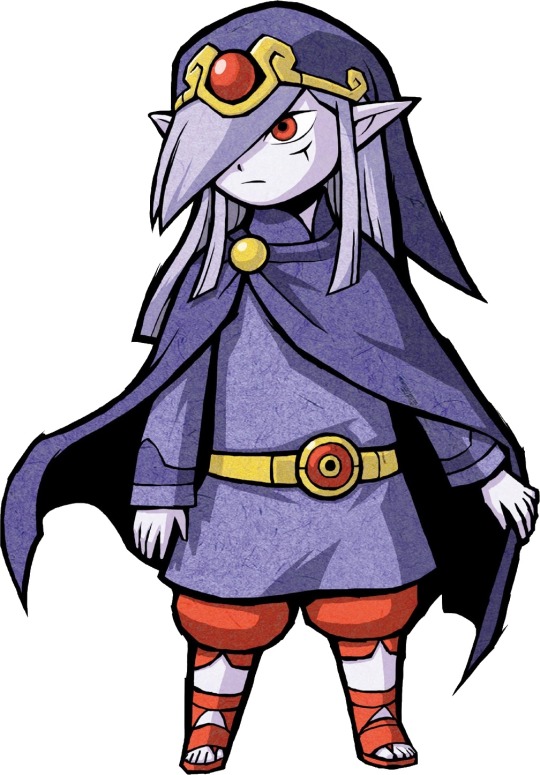
I'm talking about Vaati, the main villain in both The Minish Cap, and Four Swords, as well as the second to last boss in Four Swords Adventures (shown above in his Hylian form from The Minish Cap, and below in his demonic form from Four Swords and Four Swords Adventures). Besides Ganon, Vaati is the only other villain to be the final boss for more than one game. There are games that have final bosses that differ from Ganon, but they are usually one-offs that we never see again, or if we do see them again, they are just mini-bosses, and not the big bad guy again. The question I guess is why don't people talk about Vaati more if he is the only other repeat final villain apart from the main series bad guy?
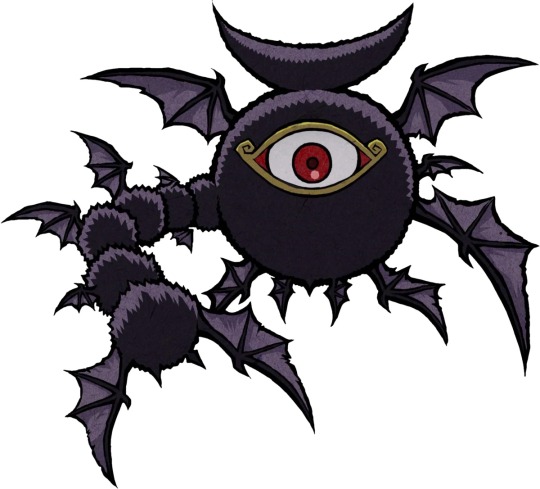
I believe part of the reason Vaati isn't discussed much, or acknowledged often by Nintendo (come on, Nintendo, I just want to fight as the Wind Mage in Hyrule Warriors) is due to the games he's from. The Minish Cap, Four Swords, and Four Swords Adventures differ heavily from the rest of the series and sort of do their own thing. Between unique weapons and game mechanics, such as a sword that splits the wielder into 4 people, and the multi-player function for both Four Swords and Four Swords Adventures, the games Vaati appears in stand out from the rest of The Legend of Zelda franchise.
I curse Nintendo for not acknowledging Vaati more, but in actuality, the Wind Mage was created by Capcom, not Nintendo. While the majority of The Legend of Zelda titles were created by Nintendo, Capcom is the only third-party development company that has been allowed to create Legend of Zelda games. Two out of the four titles Capcom helped create were The Minish Cap and Four Swords, the two games we see use Vaati as the main antagonist and final boss. Four Swords Adventures, which was a Nintendo title, used Vaati, but stuck with Ganon as the final boss.

If Capcom ever helps create another Legend of Zelda game, we may get the chance to see Vaati again (Don't hold your breath though- Capcom has not been involved in a Zelda title since The Minish Cap, which was released back in 2004). For those of you wanting more content with the Wind Mage though, I'd recommend reading both The Minish Cap and Four Swords manga created by Akira Himekawa, both of which I'll talk more on in the future.
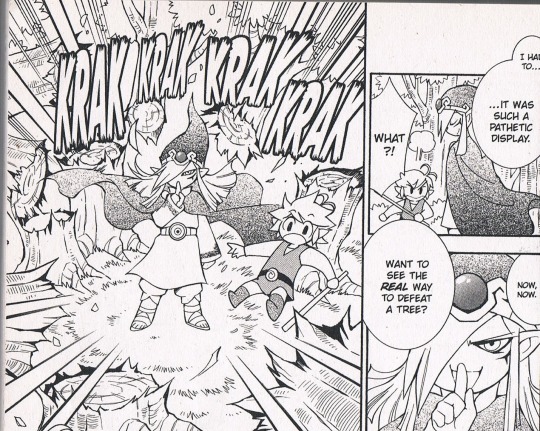
#the legend of zelda#loz#vaati#vaati the wind mage#minish cap#four swords#four swords manga#Minish cap manga#let’s talk
80 notes
·
View notes
Text
Let’s Talk The Legend of Zelda
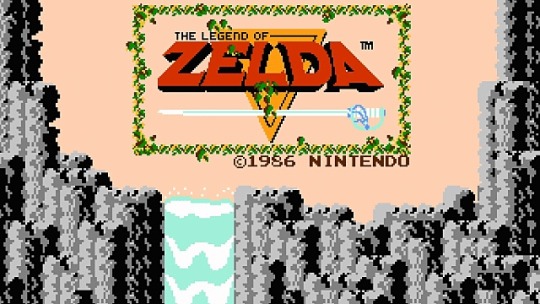
In honor of the franchise’s 36th anniversary today, I figured I’d talk about the golden NES cartridge that started it all. Released in Japan for the Famicon Disk System on February 21, 1986, The Legend of Zelda was the first game in what would eventually grow into one of Nintendo’s most successful franchises. The full title in Japan was The Hyrule Fantasy: The Legend of Zelda, but it is most commonly known now without “The Hyrule Fantasy” beginning. This was the second game I played in the series around the age of 8, but I finished it only 6 months ago, nearly 15 years later. Despite its difficulty for first time players, The Legend of Zelda is a staple game for any fan of the franchise to at least pick up and try out.

The Legend of Zelda is quick to throw you into the action. You begin on a screen with nothing except a cave in the top left. Entering it will show you the image above: an old man with fire on either side of him, a wooden sword in front of him, and the dialogue, “It’s dangerous to go alone! Take this.” Picking up the sword causes the old man to vanish, and without any further instructions, you’re left to explore Hyrule.
This is where things get confusing for newer fans/people who aren’t used to more retro-style games. There’s no tutorial, no over-world map, and no explanation of the quest. It’s just you alone in a world full of monsters, armed with a wooden sword and shield. You can go anywhere and fight anything, but if you manage to cross a bridge and hit an island with a demonic looking tree door, you’ll quickly understand what you’re supposed to be doing.
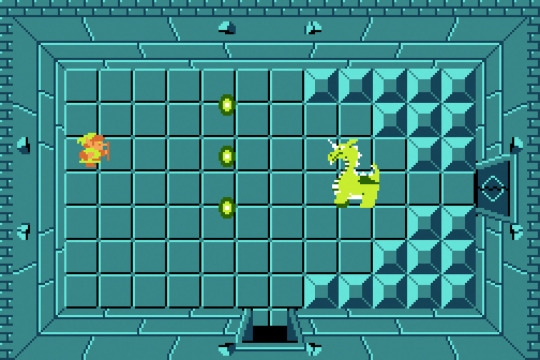
The dungeons in The Legend of Zelda are hidden throughout the land of Hyrule. It is up to Link to find them, defeat the villain inside, and collect pieces of the Triforce of Wisdom. Collecting all 8 pieces will reward him with enough power to take on the main villain of the game, Ganon, who has kidnapped the princess of Hyrule, Zelda. With the Triforce of Power on his side, Link needs to complete the other dungeons in order to challenge the Demon King himself and save both the princess and Hyrule.
Despite this being the first game of the franchise, I struggle to recommend this game first to newer Zelda fans. With very little in game plot, a lack of characters (apart from the old man and woman, and maybe the shop keeps), no in game over world map, and challenging combat, The Legend of Zelda, while iconic, is not very forgiving for fans both new and old. I do not say that to bash the game- it is worthy of respect, being the first video game to introduce the ability to save your progress, as well as kickstarting the series. However, unless you’re adamant about playing the games in release order, I recommend saving this one for later in your Zelda journey.
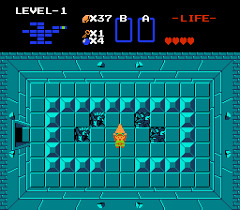
3 notes
·
View notes